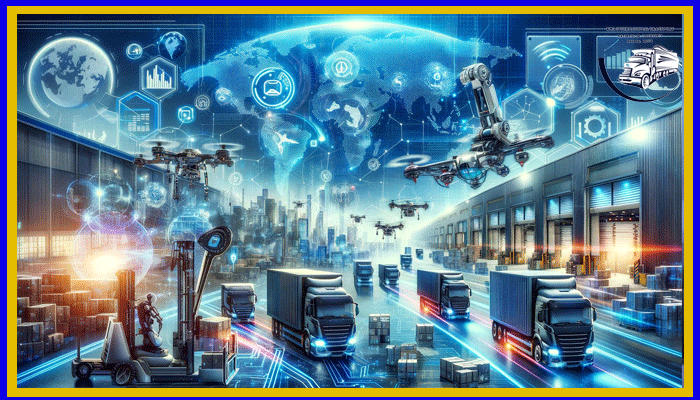Welcome to the keyhanmasirasia Site.

Moving into 2024, which logistics trends will help businesses gain a competitive advantage? We will continue with a closer look
“A vision of the future era of logistics. We’re seeing businesses transform logistics from a quiet operation to a strategic, value-driving asset, and it’s progressing. At the same time, technology visionaries are beginning to realize the opportunities more than ever before. are wide and growing. The logistics industry is developing and applying its innovative solutions worldwide and is progressing day by day.
Global supply chains often rely on a complex network of different moving parts that all work seamlessly together. However, disruptions can occur in the form of raw material shortages, supply chain failures, or shipments stuck at customs.
With logistics professionals dealing with more challenges than just shipping goods, startups selling supply chain technology that can mitigate some of the risk are getting major investment.
A supply chain risk analytics company, which uses predictive analytics and “boots on the ground” at any port in the world to identify disruptions before they become problems for customers.
We combine AI predictions and intelligence-based modeling with expert human analysis and real-world real-time insights from our global network of partners, allowing us to provide a complete view of all variables affecting the company. Supply chains, from port backups or labor unrest to weather disruptions.
This technology means that, for example, a customer in Germany can predict material shortages in China in unprecedented time and put alternative measures in place. Overcoming such disruptions leads to increased service, reduced shipping costs, and more on-time delivery.
As we head into 2024, we expect supply chain agility to be something that more businesses are investing in.
The Internet of Things refers to a network of physical objects connected to the Internet and exchanging data through the Internet. Everyday examples include smart TVs, self-driving cars, and fitness trackers.
In the supply chain, the Internet of Things is quickly becoming one of the most important tools, creating an ecosystem that harnesses traditionally unrelated assets and objects for better visibility. These connected devices share data to illuminate every milestone in the supply chain for greater flexibility and transparency.
“IoT is now in the middle of our trend radar as one of the most impactful and important trends for every organization to understand and leverage in their supply chain.”
Smart labels are a technology equipped with the Internet of Things that will revolutionize the logistics sector in the next few years. They are enhanced with intelligent inlay technology that can digitally record and communicate more information than what is printed on a physical label.
They may transmit data using quick response (QR) codes or radio frequency identification (RFID) technology, and can respond to motion, temperature, touch, and environment, and capture data from their surroundings using pixels. Record the Internet of Things. All this means complete visibility into the supply chain: faster identification of bottlenecks, improved tracking and inventory management, and protection against counterfeiting. With more investment in technology over the next few years, their applications are expected to grow even more.

3.Artificial intelligence in logistics procurement
Artificial intelligence in logistics is an exciting prospect – its potential to revolutionize the industry is seemingly limitless. The statistics speak for themselves: Accenture3 research found that 39% of large, medium and small businesses have successfully implemented artificial intelligence for supply chain and logistics processes, while 29% are on the verge of doing so. are. They were. As a result, AI is estimated to increase logistics productivity by more than 22% by 20354.
AI is having a transformative effect [across] the supply chain – on predictive forecasting, package sorting, customer service, the overall ability of a business to adapt to challenges… Many of our small business customers are in the e-commerce space, which is Highly competitive Every minute saved packing an order, or every inch of space saved in a warehouse, can quickly add up to huge cost savings.
The broad scope of AI makes it difficult to pinpoint just one or two delivery and logistics trends that will impact 2024, but here’s a snapshot:
Computer Vision: It applies artificial intelligence (AI) algorithms to analyze digital photos and videos. Applications include maintaining safety procedures—for example, during the pandemic, the technology ensured workers adhered to social distancing regulations. and inventory management – counting items and sending alerts when it’s time to restock.
Smarter inventory management: Not only can AI algorithms help retailers better predict demand – thus preventing overstocking or understocking of products – voice-activated systems allow them to track inventory levels without having to manually search a spreadsheet. Trace
Sustainability has been a growing priority for almost every industry in recent years. KPMG research5 found that more than two-thirds (69%) of CEOs globally have fully incorporated environmental, social and governance (ESG) considerations into their business. However, a similar amount (68%) admitted that their current progress on ESG is not strong enough to withstand potential scrutiny from shareholders and shareholders.
Sustainability in logistics covers many areas, but given that transportation is often the focus, it is not surprising that it is a particular focus for many businesses. With e-commerce, consumers are also paying attention, with 51% saying that understanding the carbon footprint of their delivery will be “very important” in the next 5 years.
With this in mind, some sustainability solutions your business may want to adopt in 2024 include:
Alternative fuels: DHL Express recently launched GoGreen Plus, a proprietary solution to help businesses reduce the carbon emissions associated with their shipments through the use of sustainable aviation fuel. This biofuel is produced from renewable sources such as vegetable oils, animal fats, waste materials and agricultural products. SAF is specifically designed to be used as an alternative to traditional jet fuel and can reduce greenhouse gas emissions by up to 80% compared to fossil fuels.
Electric vehicles: The electric vehicle market has grown exponentially over the past two years, with sales exceeding 10 million in 20227. In the e-commerce sector, 15-20% of last-mile freight fleets worldwide are electrified. This technology can help businesses drastically reduce their carbon emissions, save on fuel costs and attract environmentally conscious customers.

Latest trends in logistics: key points of logistics
As customer demands and supply chain pressures continue to grow, consider which of the latest innovations in technology, data and artificial intelligence could transform your business. Logistics insights that include purchasing, inventory management, last-mile delivery and even packaging help you understand where to invest your resources to stay competitive, flexible and agile in a competitive marketplace. It’s an exciting time for logistics – seize the opportunity to grow your business!
Stay up to date with keyhan masir Asia!
Learn more about the trends and changes in the transport industry, on our website and our blog. Improve your business performance with reliable logistics and transport solutions. Together we are ready to help you meet your logistics needs with ease.
To start benefiting from some of these innovations today, partner with keyhan masir Asia.